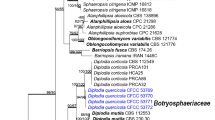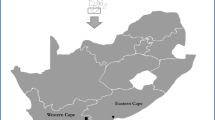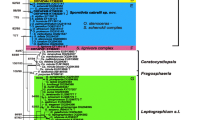Abstract
Pesotum accommodates synnematal anamorphs of Ophiostoma spp. with sympodially proliferating conidiogenous cells. These fungi are usually closely associated with wounds on trees and the insects that visit them. During tree disease surveys in Uganda, as well as studies of fungi infecting wounds on Acacia mearnsii trees in Uganda and Australia, many isolates resembling species of Pesotum were collected. The aim of this study was to identify these fungi using both morphological and DNA sequence comparisons. The Pesotum, anamorph of O. quercus was the only species collected from multiple collections in Uganda. Collections from Australia represent a new species of Pesotum described here as P. australi sp. nov.
Similar content being viewed by others
References
Acland JD (1971) Wattle. In ‘East African crops’. pp. 231–236. (Longman: London)
Barnes I, Dudzinski MJ, Old KM, Roux J, Wingfield BD, Wingfield MJ (2003) Ceratocystis pirilliformis, a new species from Eucalyptus nitens in Australia. Mycologia 95, 865–871. doi: 10.2307/3762015
Brasier CM (1990) China and the origins of Dutch elm disease: an appraisal. Plant Pathology 39, 5–16. doi: 10.1111/j.1365-3059. 1990.tb02470.x
Brasier CM (1993) The genetic system as a fungal taxonomic tool: gene flow, molecular variation and sibling species in the Ophiostoma piceae-Ophiostoma ulmi complex and ITS taxonomic and ecological significance. In ‘Ceratocystis and Ophiostoma: taxonomy, ecology, and pathogenicity’. (Eds MJ Wingfield, KA Seifert, JF Webber) pp. 77–92. (American Phytopathological Society Press: St Paul, MN)
Brasier CM, Kirk SA (1993) Sibling species within Ophiostoma piceae. Mycological Research 97, 811–816.
Brasier CM, Stephens TM (1993) Temperature growth responses distinguish the OPC and OPH sibling species within Ophiostoma piceae. Mycological Research 97, 1416–1418.
Crane JL, Schoknecht JD (1973) Conidiogenesis in Ceratocystis ulmi, Ceratocystis piceae and Graphium penicillioides. American Journal of Botany 60, 346–354. doi: 10.2307/2441201
De Beer ZW, Wingfield MJ, Kemp GHJ (1995) First report of Ophiostoma querci in South Africa. South African Journal of Science 91, 6.
De Beer ZW, Wingfield BD, Wingfield MJ (2003) The Ophiostoma piceae complex in the southern hemisphere: a phylogenetic study. Mycological Research 107, 469–476. doi: 10.1017/S0953756203007445
Felsenstein J (1985) Confidence limits on phylogenies: an approach using the bootstrap. Evolution 39, 783–791. doi: 10.2307/2408678
Geldenhuis MM, Roux J, Montenegro F, De Beer ZW, Wingfield MJ, Wingfield BD (2004) Identification and pathogenicity of Graphium and Pesotum species from machete wounds on Schizolobium parahybum in Ecuador. Fungal Diversity 15, 137–151.
Gibson IAS (1975) ‘Diseases of forest trees widely planted as exotics in the tropics and Southern hemisphere. Part I. Important members of the Myrtaceae, Leguminosae, Verbanaceae and Meliaceae.’ (Commonwealth Forestry Institute, University of Oxford: Oxford)
Glass NL, Donaldson GC (1995) Development of primer sets designed for use with the PCR to amplify conserved genes from filamentous Ascomycetes. Applied and Environmental Microbiology 61, 1323–1330.
Grosmann H (1931) Beiträge zur kenntnis der Lebensgemeinschaft zwischen Borkenkäfern und pilzen. Zeitschrift fur Parasitenkunde 3, 56–102. doi: 10.1007/BF02123692
Grosmann H (1932) Über die systematischen Beziehungen der Gattung Leptographium Lagerb. Ex Melin zur Gattung Ceratostomella Sacc. Nebst einigen Bemerkungen über Scopularia venusa Preuss and Hantzschia phycomyces Avd. Hedwigia 72, 180–198.
Halmschlager E, Messner R, Kowalski T, Prillinger H (1994) Differentiation of Ophiostoma piceae and Ophiostoma quercus by morphology and RADP analysis. Systematic and Applied Microbiology 17, 554–562.
Harrington TC (2005) Ecology and evolution of mycophagous bark beetles and their fungal partners. In ‘Insect-fungal associations: ecology and evolution’. (Eds FE Vega, M Blackwell) pp. 1–22. (Oxford University Press: New York)
Harrington TC, McNew D, Steimel J, Hofstra D, Farrell R (2001) Phylogeny and taxonomy of the Ophiostoma piceae complex and the Dutch elm disease fungi. Mycologia 93, 111–136. doi: 10.2307/3761610
Ingold CT (1971) ‘Fungal spores, their liberation and dispersal.’ (Clarendon Press: Oxford)
Katoh K, Misawa K, Kuma KI, Miyata T (2002) MAFFT: a novel method for rapid sequence alignment based on fast Fourier transform. Nucleic Acids Research 30, 3059–3066. doi: 10.1093/nar/gkf436
Kim SH, Uzunovic A, Breuil C (1999) Rapid detection of Ophiostoma piceae and O. quercus in stained wood by PCR. Applied and Environmental Microbiology 65, 287–290.
Kirisits T (2004) Fungal associates of European bark beetles with special emphasis on the ophiostomatoid fungi. In ‘Bark and wood boring insects in living trees in Europe, a synthesis’. (Eds F Lieutier, KR Day, A Battistis, JC Gregoire, HF Evans) pp. 181–235. (Kluwer Academic Press: Dordrecht, The Netherlands)
Lagerberg T, Lundberg G, Melin E (1927) Biological and practical researches into blueing in pine and spruce. Svenska Skogsv°a rdsfö reningens Tidskrift 25, 145–272.
Malloch D, Blackwell M (1993) Dispersal biology of the ophiostomatoid fungi. In ‘Ceratocystis and Ophiostoma: taxonomy, ecology, and pathogenicity’. (Eds MJ Wingfield, KA Seifert, JF Webber) pp. 195–206. (American Phytopathological Society Press: St Paul, MN)
Möller EM, Bahnweg G, Sandermann H, Geiger HH (1992) A simple and efficient protocol for isolation of high molecular weight DNA from filamentous fungi, fruit bodies, and infected plant tissues. Nucleic Acids Research 20, 6115–6116. doi: 10.1093/nar/20.22.6115
Morelet M (1992) Ophiostoma querci sur chene en France. Annales de la Societe des Sciences Naturelles et d’Archeologie de Toulon 44, 106–112.
Münch E (1907) Die blaufäule des Nadelholzes. Naturwissenschaftliche Zeitschrift für Forst-und Landwirtschaft 5, 531–573.
O’Donnell K, Cigelnik E (1997) Two divergent intragenomic rDNA ITS2 types within a monophyletic lineage of the fungus Fusarium are nonorthologous. Molecular Phylogenetics and Evolution 7, 103–116. doi: 10.1006/mpev.1996.0376
Okada G, Miyazaki S, Seifert KA, Takematsu A, Tubaki K, Yamaoka Y (1998) A molecular phylogenetic reappraisal of the Graphium complex based on 16s rDNA sequences. Canadian Journal of Botany 76, 1495–1506. doi: 10.1139/cjb-76-9-1495
Orchard AE, Wilson AJG (2001) ‘Flora of Australia. Vol. 11A, Mimosaceae, Acacia. Part 1.’ (ABRS/CSIRO Publishing: Melbourne)
Pipe ND, Buck KW, Brasier CM (1995) Genomic fingerprinting supports the separation of Ophiostoma piceae into two species. Mycological Research 99, 1182–1186.
Przybyl K, De Hoog GS (1989) On the variability of Ophiostoma piceae. Antonie Van Leeuwenhoek 55, 177–188. doi: 10.1007/BF00404757
Rayner RW (1970) ‘A mycological colour chart.’ (Commonwealth Mycological Institute and British Mycological Society: Kew, UK)
Seifert KA (1993) Sapstain of commercial lumber by species of Ophiostoma and Ceratocystis. In ‘Ceratocystis and Ophiostoma: taxonomy, ecology, and pathogenicity’. (Eds MJ Wingfield, KA Seifert, JF Webber) pp. 141–151. (American Phytopathological Society Press: St Paul, MN)
Sherry SP (1971) ‘The black wattle (Acacia mearnsii de Wild).’ (University of Natal Press: Pietermaritsburg, South Africa)
Six DL (2003) Bark beetle fungus symbiosis. In ‘Insect symbiosis’. (Eds K Bourtzis, TA Miller) pp. 97–114. (CRC Press: New York)
Stone C, Simpson JA (1987) Influence of Ips grandicollis on the incidence and spread of bluestain fungi in Pinus elliottii billets in north-eastern New South Wales. Australian Forestry 50, 86–94.
Stone C, Simpson JA (1991) Effect of six chemicals on the insects, mites, nematodes and fungi associated with Ips grandicollis (Eichhoff) (Coleoptera: Scolytidae) in north-eastern New South Wales. Journal of the Australian Entomological Society 30, 21–28. doi: 10.1111/j.1440-6055.1991.tb02187.x
Swofford DL (1998) ‘PAUP. Phylogenetic analysis using parsimony (and other methods). Version 4.’ (Sinaur Associates: Sunderland, MA)
Upadhyay HP (1981) ‘A monograph of the genus Ceratocystis and Ceratocystiopsis.’ (University of Georgia Press: Athens)
Uzunovic A, Webber JF (1998) Comparison of bluestain fungi grown in vitro and in freshly cut pine billets. European Journal of Forest Pathology 28, 322–334.
Vaartaja O (1967) The common fungal associates of the bark beetle Ips grandicollis in Pinus radiata in South Australia. Australian Forest Research 2, 40–43.
White TJ, Bruns T, Lee S, Taylor J (1990) Amplification and direct sequencing of fungal ribosomal RNA genes for phylogenetics. In ‘PCR protocols: a sequencing guide to methods and applications’. (Eds MA Innis, DH Gelfand, JJ Sninsky, TJ White) pp. 315–322. (Academic Press: San Diego, CA)
Wingfield MJ, Seifert KA, Webber JF (1993) ‘Ceratocystis and Ophiostoma: taxonomy, ecology and pathogenicity.’ (American Phytopathological Society Press: St Paul, MN)
Zhou X, De Beer ZW, Wingfield BD, Wingfield MJ (2001) Ophiostomatoid fungi associated with three pine-infesting bark beetles in South Africa. Sydowia 53, 290–300.
Zipfel RD, De Beer ZW, Jacobs K, Wingfield MJ, Wingfield BD (2006) Multigene phylogenies define Ceratocystiopsis and Grosmannia distinct from Ophiostoma. Studies in Mycology 55, 75–97.
Author information
Authors and Affiliations
Corresponding author
Rights and permissions
About this article
Cite this article
Nkuekam, G.K., Jacobs, K., de Beer, Z.W. et al. Pesotum australi sp. nov. and Ophiostoma quercus associated with Acacia mearnsii trees in Australia and Uganda, respectively. Australasian Plant Pathology 37, 406–416 (2008). https://doi.org/10.1071/AP08027
Received:
Accepted:
Issue Date:
DOI: https://doi.org/10.1071/AP08027




